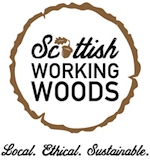How the Scheme Operates
The Label Scheme is operated by a consortium of organisations representing businesses producing goods with a significant component of materials derived from Scottish woodlands. These are currently the Association of Scottish Hardwood Sawmillers (ASHS), the Scottish Furniture Makers Association (SFMA) the Scottish Wild Harvests Association (SWHA) and Scottish Basketmakers’ Circle. These organisations are the members of the company which owns and manages the label – Working Woods Scotland Ltd.
Only members of one of these participating associations are eligible to join the Label Scheme, so that members are helped and encouraged to follow the rules and increase the range of products which can be labelled.
Once a company has been accepted as a licensee of the Label Scheme, it can use the label to identify those products which meet the label criteria. The company may also make and sell products which do not carry the label because they do not meet the criteria (eg if they do not contain a high enough proportion of Scottish material). If a company reaches higher standards, it can use the SWW logo on its publicity material.
If a business misuses the label, it will be required to correct this imediately, or its licence to use the label can be withdrawn.
A list of Label Scheme members is contained in this website. If you see anyone selling goods carrying the label who is not on the list, please contact the Scheme by email (see contact page).
If you are a producer and would like to use the label, please email Scottish Working Woods.
Principles of the label
Products carrying the label help to deliver benefits including some or all of the following:
- Economic
- Creating value in the local economy – adding value to a local natural resource which is retained in the local economy
- Wise use of a natural resource – Scotland’s woodlands can produce large amounts of these products, which can be harvested without damage to the environment. The natural qualities of these materials – beauty, durability and tastiness(!) – make them suitable for many different uses, although they have been largely ignored in recent times.
- Environmental
- Biodiversity – encouraging interest in (and economic viability of) growing and managing native broadleaved woodlands which have a very high biodiversity value
- Cutting greenhouse gas emissions – reducing reliance on imports and long-distance transport
- Reducing waste – much locally produced hardwood timber would otherwise go to landfill sites.
- Social
- Providing local employment – providing jobs in processing and manufacturing and supports jobs in forestry
- Amenity – supporting the management of woodlands that provide landscape amenity and wonderful places for walking and recreation.
- Socio-cultural sustainability – traditional knowledge is often associated with woodland products and by investing in these products that knowledge is maintained and strengthened in society. Similarly many woodland products are sourced from within remote, sometimes small, rural communities and therefore their sale helps to maintain these communities.

